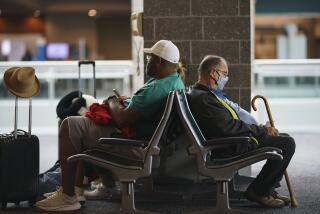Traveling the globe? Be sure to pack CDC’s ‘Yellow Book’
The “Yellow Book,” long the health bible for international travelers, has gone mainstream.
The book, produced annually by the national Centers for Disease Control and Prevention, is now available through bookstores and online, not through government printing sources as in previous years.
The 2005-06 edition -- released in May and officially called “Health Information for International Travel” -- includes changes in vaccine recommendations, updated malaria prevention information by country, recommendations for immigrants to the U.S. who are traveling to their homelands, and other advice.
It also contains information on vaccinations necessary for specific locations worldwide, tips on preventing travel-associated diseases (including cholera, typhoid fever and leishmaniasis), as well as ways to avoid sunburn, motion sickness, jet lag, food poisoning from marine toxins and animal-associated hazards.
The book lists for $24.95 and is sold at Barnes & Noble and through Amazon.com. It’s also for sale through the new publisher, Elsevier, (800) 545-2522 or www.us.elsevierhealth.com.
*
Clot-fighting stockings
Long-HAUL airline travelers should consider wearing compression stockings, according to the authors of a research review published in the July issue of the Journal of Advanced Nursing.
The researchers evaluated the results of nine studies conducted in Britain and Italy involving nearly 2,500 fliers over two years and concluded that the stockings reduced the risk of deep vein thrombosis, blood clots that develop in a deep vein, typically the leg. The clots can become dangerous if they break off and travel in the bloodstream to the lungs.
Only two of the 1,237 study subjects who wore compression stockings developed deep vein thrombosis, but of the 1,245 subjects in the control group who didn’t wear the stockings, 46 got clots. The passengers were both at high and low risk for the clots.
What kind of stockings are best? In general, a “below-knee, medium compression pressure -- depending on the manufacturers, usually 14 to 17 or 20 to 30 millimeters of mercury,” says Hsiu-Fang Hsieh, an assistant professor of nursing at Fooyin University in Taiwan and one of the co-authors. “Higher compression pressure is only indicated for [those] at high risk” of deep vein thrombosis.
Compression stockings are available at travel stores or online and sell for about $12 and up.
“The greater the graduated pressure, the greater the reduction in venous pressure,” Hsieh says. “You want to make sure a higher compression pressure is at the ankles and a lower compression pressure is around the knees.”
*
For diabetics
Traveling with diabetes can be a challenge. To help, Los Angeles attorney Marilyn L. Garcia, who has insulin-dependent diabetes, has written “Diabetic Travel Tales and Tips: Adventures From Around the World,” $13.95. It’s available at Amazon.com.
It’s not the typical don’t-forget-your-insulin-supplies guide. Instead, Garcia and other diabetics write about traveling despite having the disease. “I tried to make it fun and practical,” Garcia says. “As a diabetic, I’d gotten into a lot of scrapes that were amusing and I survived.”
The book also contains practical information, such as adjusting insulin doses to changes in time zones, dealing with airport security, scheduling meals and buying medicine at foreign destinations.
*
Healthy Traveler appears every other week. Kathleen Doheny can be reached at kathleen [email protected].
More to Read
Sign up for The Wild
We’ll help you find the best places to hike, bike and run, as well as the perfect silent spots for meditation and yoga.
You may occasionally receive promotional content from the Los Angeles Times.





